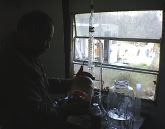Ecogenics, Inc.

Alcohol On-Farm Production

- Could I make grain alcohol on my farm?
Yes. In fact, nearly 22,000 farmers have applied for permits to do just that.
- Is distillation difficult?
Not really. The process involves converting the starchy content of the corn (or other energy material) to sugar, then to alcohol ... and finally "boiling off" the alcohol from the water.
- Where could I get help if I wanted to build an on-farm still?
The Alternative Energy Coalition has developed a useful handbook, which provides rather detailed information about farm stills, supplies, sources for the yeast and enzymes needed in the process. Call or write for a copy.
- Are there blueprints or plans available?
Several engineering firms are working with farmers on developing small stills. Also, several universities are building "pilot" stills.
- How much alcohol can I get from corn?
With a reasonably efficient facility, you'll about 2.6 gallons of 165-proof alcohol per bushel of corn.
- How much would a farm still cost?
If you can furnish your own labor, some welding and such, you could probably build a unit for as little as $2,000. Cost can be much higher depending on how much automation you include, and how much equipment for quality control.
- What are the by-products of corn alcohol?
The chief by-product is a concentrated, high-protein livestock feed. Since distillation removes only the starch in the grain, virtually all of the feed value remains. This feed material is commonly called distillers grain. (The other by-product is carbon-dioxide, which has little value in small quantities and is not considered a value product in small stills.)
- What about alcohol storage? Does it evaporate fast?
Store it exactly as you would gasoline. If your storage tank is underground or located in good shade, you'll have no special problems with alcohol.
Back to Ecogenics home page


